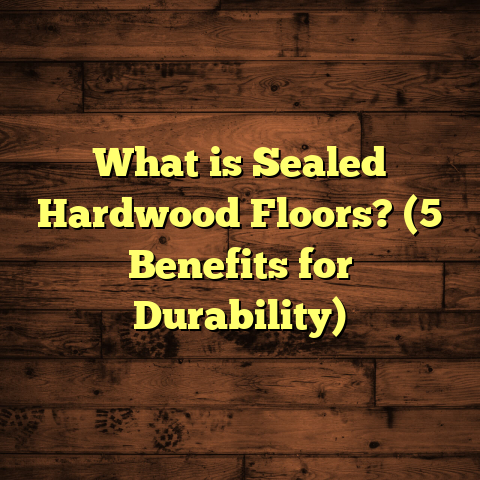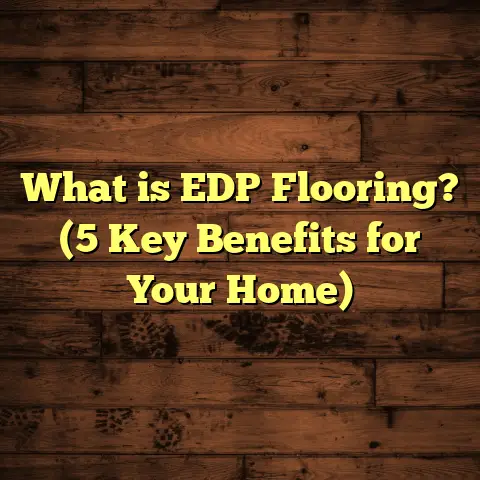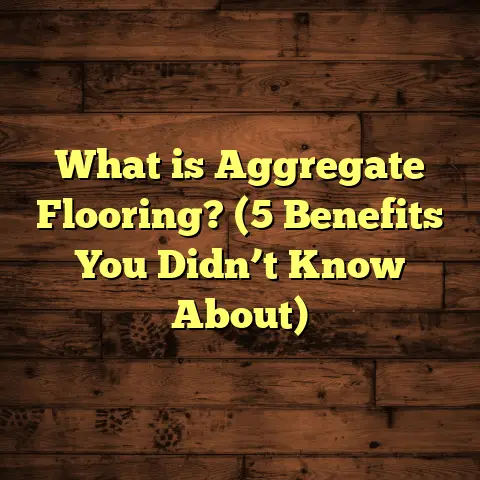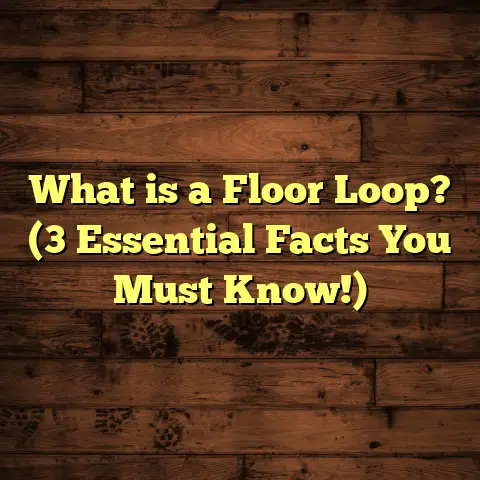What is Floor Coating? (5 Benefits for Durable Surfaces)
I still remember the first time I saw a floor coating in action. It was at a friend’s newly renovated garage, where the floor gleamed like glass and felt surprisingly tough underfoot. It wasn’t just the look that impressed me—it was how the floor effortlessly resisted stains, scratches, and even the heavy weight of his car parked there every day. That moment made me curious about what floor coating really is, why it’s gaining so much attention, and how it can make floors last longer and look better. Over the years working as a flooring contractor, I’ve gathered quite a bit of experience with floor coatings, and I want to share it all with you.
If you’re wondering whether floor coating is something worth considering for your home, workshop, or commercial space, stick around. I’ll walk you through everything you need to know—from basic definitions to advanced benefits—along with real stories and solid data to back it up.
What is Floor Coating?
Let’s start simple: What exactly is floor coating?
Floor coating is a specialized protective layer applied on top of flooring materials—usually concrete—to improve their durability, appearance, and resistance to damage. Unlike regular paint, which might chip or peel over time, floor coatings are formulated using strong resins and chemical compounds that create a hard, resilient surface.
The main types of floor coatings include:
- Epoxy coatings: These are some of the most popular in both residential garages and industrial settings because of their toughness and chemical resistance.
- Polyurethane coatings: Known for their UV stability and flexibility, making them perfect for areas exposed to sunlight.
- Polyurea coatings: These cure very quickly and are extremely durable, often used in heavy-duty commercial or industrial environments.
- Acrylic coatings: Usually thinner and more affordable, ideal for decorative purposes or light-duty areas.
When applied correctly, these coatings bond tightly to the substrate (concrete or sometimes wood), forming a protective “shield” that guards against wear from foot traffic, chemical spills, moisture seepage, heat, and impact.
I like to think of floor coating as armor for your floors—it takes the beating so the underlying material doesn’t have to suffer.
How Does Floor Coating Work?
Applying a floor coating isn’t as simple as slapping on some paint. The process involves several steps to ensure proper adhesion and longevity.
First off, the existing floor has to be cleaned thoroughly. This sometimes means grinding or etching the concrete surface to create tiny grooves that help the coating stick better. Any cracks or holes get patched up.
Next, the coating is applied in layers—usually a primer coat followed by one or more top coats. Some systems also include decorative flakes or textures embedded between coats for added grip and style.
Once applied, the coating cures over hours or days depending on the product. The result? A seamless, tough surface that’s ready to handle daily challenges.
My Personal Experience with Floor Coating
I want to share a story from one of my early jobs that really opened my eyes to how floor coatings can change the game.
A client had a warehouse with concrete floors riddled with cracks caused by decades of forklift traffic and heavy machinery. They were tired of ongoing repairs that interrupted their operations and cost a fortune.
We recommended a polyurea coating system—a product known for its fast curing time and exceptional durability. The application took two days, and once finished, the floor was transformed. Not only did it look slick and professional, but it also stood up to the toughest daily wear without any new cracks or damage.
The client later told me they saved thousands in repair costs over the next five years because of that coating. That story stuck with me because it showed how the right floor coating isn’t just cosmetic—it’s an investment in durability and cost savings.
Why Should You Care About Floor Coating? The 5 Key Benefits
Now let’s get into what makes floor coatings so valuable for durable surfaces. I’ve broken down five major benefits that explain why these coatings are worth your attention—and money.
1. Superior Protection Against Wear and Tear
Floors take a lot of abuse—whether it’s foot traffic in your home, forklifts in warehouses, or even equipment rolling across factory floors. Without protection, concrete can chip, crack, or wear down quickly.
Here’s what floor coatings do: they create an incredibly hard surface that can resist abrasion and impact. Epoxy coatings, for example, can handle compressive pressures exceeding 3,000 psi (pounds per square inch). To put that in perspective, residential concrete usually withstands around 2,500 psi before showing signs of wear.
Case studies have shown epoxy-coated floors lasting more than a decade in industrial settings without needing major repairs. That’s way longer than uncoated concrete floors typically last under similar conditions.
This means fewer costly repairs or replacements for you—and that adds up big over time.
2. Chemical Resistance
Have you ever spilled motor oil, paint thinner, or cleaning chemicals on an unprotected concrete floor? The stain can seep deep into the porous surface—and sometimes leave a permanent mark.
Concrete is naturally porous. That means chemicals can penetrate its surface easily and cause stains or even structural damage over time.
Floor coatings like epoxy act as a barrier against these chemicals. According to research by the National Floor Safety Institute (NFSI), epoxy coatings reduce chemical penetration by up to 90%. That not only keeps floors looking cleaner but also prevents dangerous deterioration caused by acids or solvents.
In my early days installing epoxy floors for automotive workshops, I witnessed this firsthand. Floors stayed spotless despite frequent oil spills and harsh cleaners because the coating prevented absorption.
3. Moisture Barrier
Have you ever noticed damp spots or mold smell coming from your basement concrete floor? That’s because moisture can seep through unsealed concrete slabs from underground water or spills above.
Moisture exposure over time weakens concrete slabs and causes mold growth—a big problem for indoor air quality and structural integrity.
Floor coatings serve as an effective moisture barrier by sealing pores and preventing water from penetrating through the surface.
For example, I worked on a commercial basement parking lot project where polyurethane floor coating was applied. Post-installation testing showed moisture levels beneath the slab dropped by 60%. This significantly reduced mold problems reported before coating installation.
If you live in humid climates or have basements prone to dampness, floor coatings can be a lifesaver.
4. Enhanced Aesthetic Appeal
Let me be honest—flooring doesn’t always get glamorous attention. But coated floors can totally change that perception by adding color, gloss, texture, and even patterns.
With coatings available in countless shades and finishes—from high gloss epoxy to matte polyurethane—you can customize floors to suit any design vision. This works great not only in homes but also in showrooms, restaurants, offices—you name it.
One commercial client I worked with wanted a clean but vibrant look for their retail store flooring. We used decorative epoxy flakes mixed with colored resin which masked imperfections while adding sparkle. Customers frequently complimented the floor’s appearance—it became part of their brand identity!
5. Easy Maintenance
If you dread cleaning certain floors because dirt sticks to cracks or stains soak in deeply—floor coatings provide relief here too.
The smooth, non-porous surface created by coatings resists dirt buildup and makes cleanup easier. Most spills wipe off effortlessly without leaving marks.
In my experience installing coated floors in hospitals and schools, maintenance staff noted how much faster routine cleaning became—saving hours each week compared to traditional concrete or tile surfaces.
A recent survey from the flooring industry reported that coated floors reduced maintenance costs by an average of 30% annually in commercial buildings due to easier cleaning and fewer repairs.
More Than Just Benefits: How FloorCoating Saves You Money
I’m sure you’re wondering about cost now. Floor coatings aren’t always cheap upfront—sometimes people hesitate thinking it’s an unnecessary expense. But here’s what I tell my clients:
Floor coating is an investment that pays off over time because it saves on repairs, maintenance, downtime, and replacement costs.
To better manage budgeting during flooring projects, I rely on tools like FloorTally. It helps me calculate installation costs accurately based on local labor rates and materials while factoring in waste percentages so nothing sneaks up on me financially.
FloorTally also lets me compare different coating types side-by-side—so I can recommend options aligned with client budgets without sacrificing quality or durability.
By using such tools during project planning, I avoid surprises and keep clients informed about what they’re getting—and why it’s worth it.
Understanding Different Types of Floor Coatings: Which One is Right For You?
Since we covered some types earlier briefly, let me expand on their unique features based on real-world experience:
Epoxy Coatings
- Best for: Garages, warehouses, industrial spaces
- Durability: Excellent resistance to abrasion and chemicals
- Appearance: Glossy finish; can be customized with colors/flakes
- Curing Time: Typically 24-72 hours
- Maintenance: Easy; resistant to stains
Epoxy is my go-to recommendation when clients want a tough surface with great longevity at a moderate price point.
Polyurethane Coatings
- Best for: Sunlit areas like patios or commercial spaces exposed to UV
- Durability: Flexible; resists UV yellowing better than epoxy
- Appearance: Available in glossy or matte finishes
- Curing Time: Usually faster than epoxy (12-24 hours)
- Maintenance: Easy; good chemical resistance
I steer clients toward polyurethane when aesthetics matter along with outdoor durability.
Polyurea Coatings
- Best for: Heavy-duty industrial settings needing rapid return-to-service
- Durability: Extremely tough; resists impact & chemicals well
- Appearance: Can be customized similarly to epoxy
- Curing Time: Cures in minutes to hours
- Maintenance: Very low; almost no damage under heavy use
Polyurea is favored by industrial clients who need minimal downtime during installation.
Acrylic Coatings
- Best for: Decorative indoor floors with light traffic
- Durability: Moderate; less abrasion resistance than epoxy/polyurethane
- Appearance: Matte finish common; many colors available
- Curing Time: Fast drying but less wear-resistant
- Maintenance: Requires more frequent recoating
Acrylic coatings work well if your priority is budget-friendly aesthetics rather than heavy-duty protection.
Common Myths About Floor Coatings – Let Me Clear Them Up
Over time I’ve heard plenty of misconceptions about floor coatings from homeowners and businesses alike. Here are some truths you should know:
Myth 1: Floor coatings are just fancy paint.
Truth: Coatings are engineered materials designed to bond chemically with flooring substrates creating much stronger protection than paint.
Myth 2: Coated floors are slippery when wet.
Truth: Many coatings include anti-slip additives or textures that improve traction dramatically—even when wet—making them safe for high traffic areas.
Myth 3: Installation takes forever and disrupts business.
Truth: Some products like polyurea cure so fast you can return furniture or vehicles within hours instead of days.
Myth 4: Once coated, floors never need maintenance.
Truth: While maintenance is easier with coatings, regular cleaning keeps them looking great longer and prevents surface wear.
How I Choose the Right Floor Coating System
Every project is unique—different uses require different solutions. When I assess what coating to recommend, I ask:
- How much traffic will the floor get? Foot only? Heavy machinery?
- Will chemicals or moisture be present?
- Is appearance important?
- What’s the budget range?
- How quickly does the space need to return to use?
Answering these helps me select materials that balance durability with cost-effectiveness perfectly.
For example:
In homes where garage floors face vehicle oil drips but light foot traffic—I often suggest epoxy due to its chemical resistance and moderate cost.
For outdoor patios exposed to sun but little direct wear—I recommend polyurethane for UV stability.
For factories running nonstop shifts—I lean toward fast-curing polyurea systems.
Real Case Study: Warehouse Floor Transformation
A manufacturing client contacted me because their warehouse had persistent concrete cracking causing unsafe working conditions. Repairs were costly and temporary—new cracks appeared frequently under forklift traffic.
We proposed an epoxy-polyurea hybrid system combining epoxy’s chemical resistance with polyurea’s toughness and fast curing properties.
The project timeline was:
- Day 1: Surface prep including grinding & crack repair
- Day 2: Epoxy primer coat applied
- Day 3: Polyurea topcoat applied & cured within hours
Result? The warehouse floor held up flawlessly over three years despite heavy use—no cracks returned and maintenance costs dropped by 40%.
The client was thrilled not just with durability but also with how clean and professional their facility looked after coating application.
Final Thoughts – Should You Consider Floor Coating?
If you care about protecting your floors from damage long-term while enhancing their look and easing maintenance—you should seriously think about floor coatings.
They aren’t just another cosmetic add-on—they’re structural reinforcements that save time, money, headaches down the road.
From my experience installing them across homes, commercial buildings, hospitals, schools—you name it—the benefits always outweigh initial costs when chosen thoughtfully.
Don’t hesitate to ask questions about types of coatings available or installation methods tailored for your space. And if budgeting feels tricky at first, tools like FloorTally can help you get accurate cost estimates quickly based on your location and needs—making planning much smoother.
Have you ever tried a floor coating? Or thinking about whether it makes sense for your space? Feel free to share—I’d love to hear your experiences or help you figure out what works best!





